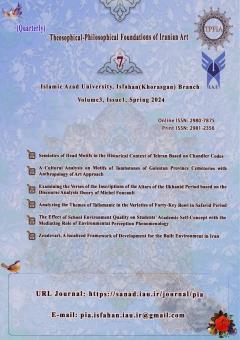Semiotics of Head Motifs in the Historical Context of Tehran Based on Chandler Codes
Subject Areas : Art
Sara Sadat Miri
1
,
Firoozeh Sheibani Rezvani
2
*
![]()
1 - Master of Arts Student, Islamshahr Branch, Islamic Azad University, Islamshahr, Iran
2 - Assistant Professor of Art Department, Islamshahr Branch, Islamic Azad University, Islamshahr, Iran.
Keywords: Chandler Codes, Pattern Analysis, Qajar Head Motifes, Semiotics, Tehran's Historical Context.,
Abstract :
This research aims to identify visual characteristics in the motifs of three selected fronts of Foroozesh Street, Molavi Street, and Vakil Al-Tajjar Street in the historical context of Tehran, which has been less studied. The reason for choosing these three heads among similar cases was the capacity to analyze their motifs from the perspective of Daniel Chandler's codes. This research is qualitative and based on data obtained from library information and observation of case examples that describe and analyze motifs based on Daniel Chandler's semiotic opinions. The results of the analysis are as follows: From the point of view of social codes, it shows the integrated style of cultural exchange between the rulers of Qajar and the West. From the point of view of the textual ciphers, brickwork, and tilework motifs are explained in the visual text of Islamic elements, Khatai, birds, and written verses. In interpretative codes of visual elements, it explains the royal authority as well as the importance of living in the shadow of faith in the One Lord and the fruits of faith of a Muslim person. Perceptual codes are interpreted based on the similarity of the elements in the motifs of the three heads. Finally, from codes of perception, show the orientation of the leader's and the audience's thinking about the natural elements of the garden symbolically and abstractly.
احمدی، بابک (1383)، از نشانه تصویری تا متن، چاپ چهارم، تهران: نشر مرکز.
بلیلاناصل، لیدا.حسن پورلمر، سعید (1398). «الگوهای هندسی و تناسبات طلایی، زبان مشترک معماری و هنر در روستای تاریخی ابیانه»، فصلنامۀ علمی معماری اقلیمی گرموخشک، دوره7، شماره9.
https://smb.yazd.ac.ir/article. آخرین دسترسی (7/12/1402)
پنجه باشی، الهه، دولاب فاطمه. (1397). مطالعه ویژگی و ساختار نقوش سردر بناهای کاشیکاریشده در شیراز. فصلنامه نگره 13(48), 104-125 doi: 10.22070/negareh.2019.886
پنجه باشی، الهه. (1402). «مطالعه مؤلفههای ساختاری و معنایی سر در و دو ستون کاشی نگاری شده بارگاه حضرت سلیمان اثر استاد ابراهیم در شیراز دوره قاجار». مجله مطالعات ایرانی, 149-211. doi: 10.22103/jis/jis.2024.21568.2492
چندلر، دانیل (1386). مبانی نشانهشناسی، مترجم: مهدی پارسا، چاپ اول، تهران: سوره مهر.
چندلر، دانیل (1387). مبانی نشانهشناسی، مترجم: مهدی پارسا، چاپ دوم، تهران: سوره مهر.
سوسور، فردینان¬دو (1398). ¬زبان¬شناسی عمومی، مترجم: کوروش صفوی، تهران: انتشارات هرمس.
شیخینارانی، هانیه (1389). «نشانهشناسی پرنده، طاووس»، نقش مایه، بهار و تابستان، سال سوم، شماره 5، 27-42. www.noormags.ir/ view/fa/articlepage/1494793/ آخرین دسترسی (15/1/1403)
شاطری وایقان، امید. دبدبه، محمد (1398). «رویکرد احیای بافتهای تاریخی و ارزشمند شهری در حفظ هویت معماری بناها»، مجلZ مطالعات طراحی شهری و پژوهشهای شهری، سال دوم - شماره 4، ص57 تا 64. www.noormags.ir/view/fa/articlepage آخرین دسترسی (7/12/1402)
فاسترگیچ، مارک (1400). نظریه¬های زیبایی¬شناسی، ترجمه: احسانحنیف، چاپ نخست، تهران: کتاب فکر نو.
کریستی، آنتونی (1401). اساطیر چین، ترجمه: باجلانفرخی، چاپ چهارم، تهران: انشارات اساطیر.
گودرزی، مرتضی (1388). آیینه خیال: بررسی و تحلیل تزیینات معماری دوران قاجار، چاپ اول، تهران: انتشارات سوره مهر.
نیکولز، بیل (1392). ساختارگرایی، نشانه شناسی سینما، مترجم: علاءالدینطباطبایی، چاپ چهارم، تهران: انتشارات هرمس.
وارنر، رکس (1400)، دانشنامۀ اساطیر جهان، ترجمه: ابوالقاسماسماعیلپور، چاپ چهارم، تهران: انتشارات اساطیر.
یزدانی، علیرضا (1396). درآمدی بر نشانه شناسی گرافیک معاصر ایران، چاپ نخست، تهران: نشر نظر

